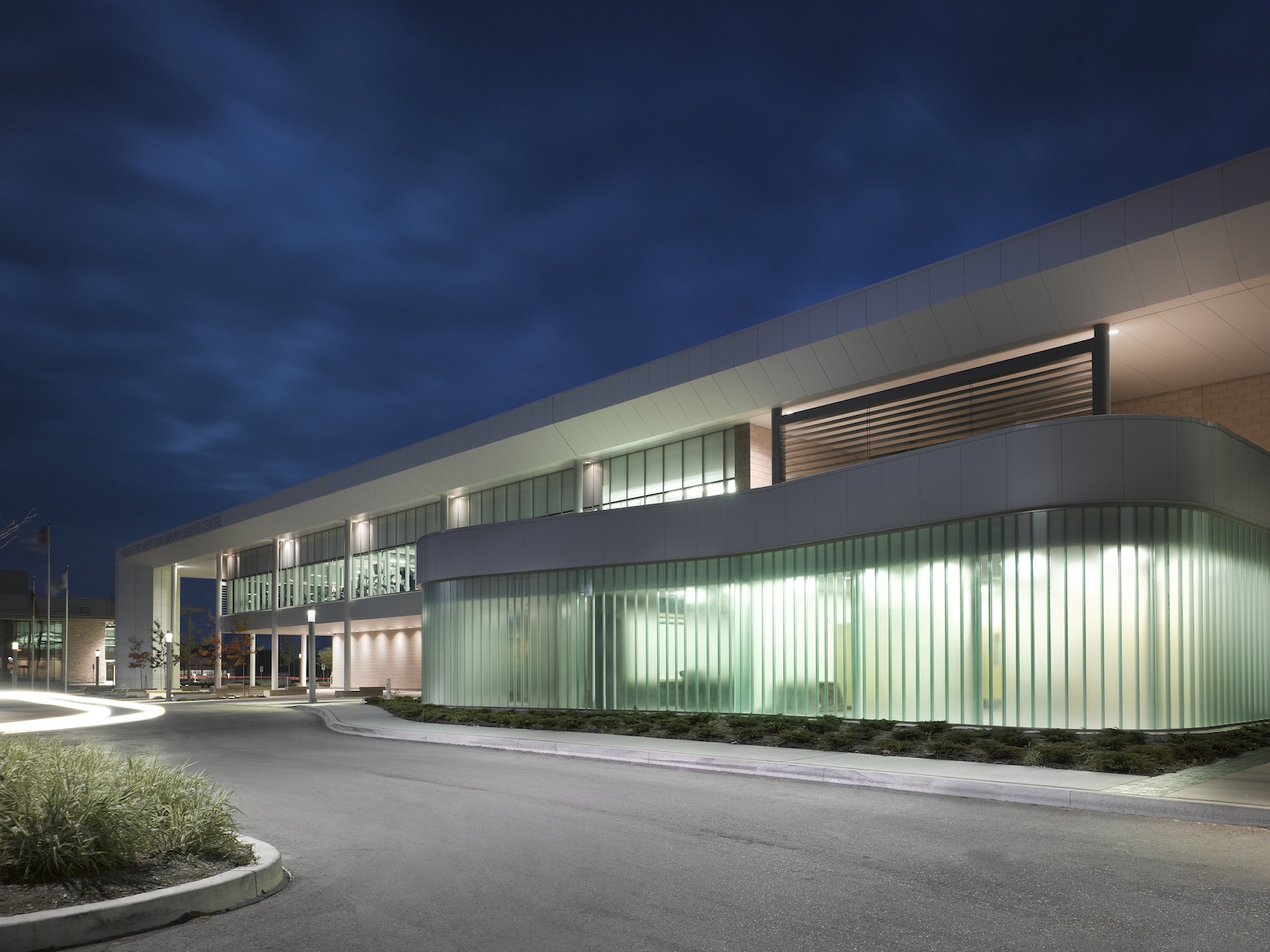Project: Bradford West Gwillimbury Leisure Centre
Location: Ontario, Canada
Architect: Salter Pilon Architecture in association with Lett Architects
Glazing Contractor: Aeroloc Industries
Channel Glass Supplier: Technical Glass Products
Glass Style: Pilkington Profilit™ channel glass; low-e tempered Pilkington Profilit channel glass
Ontario's new Bradford West Gwillimbury Leisure Centre, designed by Salter Pilon Architecture, is one of the largest multi-use recreation facilities in the province. However, it does more than foster a healthy lifestyle through recreational and cultural activities. Its 1,400-sf serpentine channel glass wall delivers dramatic visual appeal for residents—one of the town's three core visions for the new facility.
To create the curving glass façade, the design team turned to Pilkington Profilit™ channel glass. Unlike conventional windows and glass block, its slender frames and narrow channel glass segments allow for tight radii—as low as 1.9 meters (78 in.). While this flexibility enabled the design team to create a serpentine configuration, one technical challenge was ensuring a homogenous appearance in areas of the facade with different radii. Channel glass segments tangent to one another flow smoothly into adjacent curves or straight sections. Creating a seamless transition is more complex where different radii prevent tangent segments.
To ensure the U-shaped channel glass system did not interfere with the joint connection and interrupt the channel glass wall’s uniform look, flanged L-shaped channel glass planks were installed on one side of the joint transition and full U-shaped channel glass planks on the opposing side. This configuration allowed the channel glass framing head and sill components to be stretch-formed into a smooth continuous structure with a precise radius.
The serpentine channel glass application is formed of a mixture of standard cast glass and clear channel glass. The standard cast glass diffuses light through its textured surface while also obscuring vision. Clear cast glass adds a second layer of visual interest and provides occupants with greater access to daylight and views to nature. This glazing combination helps the system meet the different light transfer, privacy and visibility needs of the various rooms it encloses. A low-emissivity coating further boosts the façade’s thermal performance.
The completed façade flanks the Bradford West Gwillimbury Leisure Centre’s east exterior wall. It breaks up the building’s rectangular shape and serves as a surround for a lobby, meeting room and multipurpose room. By day it transmits light into the leisure centre’s interior rooms. By night, its backlit form helps welcome people inside.
TGP’s Pilkington Profilit channel glass soars up to 23 feet, can be installed vertically or horizontally, and formed into straight or curved walls. It is available in a variety of textures and colors with varying degrees of translucency, allowing light through while maintaining privacy. Pilkington Profilit can be used in interior or exterior applications, with insulating Lumira® aerogel for superior energy efficiency.
For more information on Pilkington Profilit channel glass, along with TGP’s other specialty architectural glazing materials, visit www.tgpamerica.com.
Technical Glass Products
800.426.0279
800.451.9857 – fax
sales@fireglass.com
www.fireglass.com
Related Stories
| Aug 11, 2010
PCA partners with MIT on concrete research center
MIT today announced the creation of the Concrete Sustainability Hub, a research center established at MIT in collaboration with the Portland Cement Association (PCA) and Ready Mixed Concrete (RMC) Research & Education Foundation.
| Aug 11, 2010
29 Great Solutions for the AEC Industry
AEC firms are hotbeds of invention and innovation to meet client needs in today's highly competitive environment. The editors of Building Design+Construction are pleased to present 29 "Great Solutions" to some of the most complex problems and issues facing Building Teams today. Our solutions cover eight key areas: Design, BIM + IT, Collaboration, Healthcare, Products, Technology, Business Management, and Green Building.
| Aug 11, 2010
Portland Cement Association offers blast resistant design guide for reinforced concrete structures
Developed for designers and engineers, "Blast Resistant Design Guide for Reinforced Concrete Structures" provides a practical treatment of the design of cast-in-place reinforced concrete structures to resist the effects of blast loads. It explains the principles of blast-resistant design, and how to determine the kind and degree of resistance a structure needs as well as how to specify the required materials and details.
| Aug 11, 2010
'Flexible' building designed to physically respond to the environment
The ecoFLEX project, designed by a team from Shepley Bulfinch, has won a prestigious 2009 Unbuilt Architecture Design Award from the Boston Society of Architects. EcoFLEX features heat-sensitive assemblies composed of a series of bi-material strips. The assemblies’ form modulate with the temperature to create varying levels of shading and wind shielding, flexing when heated to block sunlight and contracting when cooled to allow breezes to pass through the screen.







